A hat for a little girl can be knitted with your own hands. There are a large number of patterns of varying complexity. Each needlewoman can choose a pattern that suits her skill level.
What do you need to knit a hat for a girl with knitting needles
To make a product, you need to choose yarn and buy knitting needles that match it. All this is available in specialized stores. There are patterns for knitting hats on 2 and 5 knitting needles. Before buying materials, you need to study the instructions, which usually indicate the number of working knitting needles and the type of yarn.
The patterns are designed for a certain thread thickness. If you use thinner or too thick yarn, the product will be of a different size.
Selecting yarn
The yarn for knitting a hat is selected depending on its purpose. A summer headdress is woven from cotton iris and flax. For a winter hat, wool or its synthetic analogues will be needed. Manufacturers indicate the composition of the yarn on the packaging.
A children's product can be knitted from the following types of threads:
- Wool yarn. Suitable for making warm clothes. Natural wool is very warm, looks beautiful, but quickly loses shape and appearance. The most expensive types of wool yarn are angora, cashmere, mohair, alpaca.
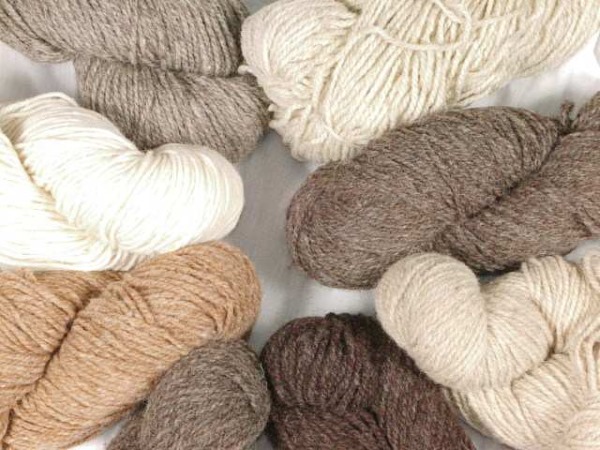
- Blended yarnWool with added acrylic retains the best qualities of natural fiber, while synthetics make it wear-resistant.
- Acrylic. Synthetic fiber, almost never used in its pure form. It is used to make mixed yarns. Products with more than 50% acrylic absorb moisture poorly, are highly electrified, and look cheap.
- Linen, silk, cotton. Threads made from natural fibers are suitable for making summer clothes. They have good hygroscopicity and do not cause allergic reactions.
- Bamboo. Threads from this fiber have antimicrobial properties. The yarn does not cause allergies. Things made from bamboo do not deform and absorb moisture well.
The choice of yarn quality and color depends on the product sketch. For a multi-colored hat consisting of identical segments, you will have to buy several skeins of thread. The remainder of the yarn will make a scarf and gloves. If the pattern is created by changing threads, take yarn of the same type with the same thickness, but different colors.
This is the only way to get a product with the same density of the fabric. Downy items are often knitted in two threads, one thin cotton, and the other from the undercoat of animals.
Calculating the amount of yarn
The knitting pattern usually comes with detailed instructions. Often magazines publish only a drawing and an image of a hat for girls. In such cases, you will have to calculate the amount of thread yourself. To do this, you need to knit a small sample according to the pattern in the manual.
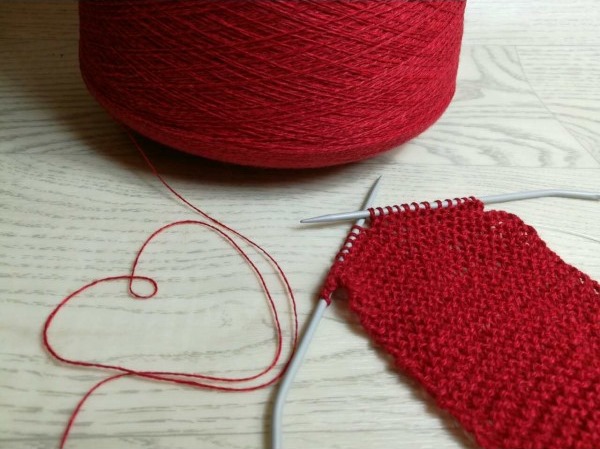
Each package has two numbers separated by a slash, for example 15/6, 32/2. The first number before the line indicates the volume of the yarn. The second number indicates the number of strands that make up the thread. Bulk yarn with a small number of twists is consumed less.
To accurately calculate the required amount of source material, you need to:
- Make a drawing of the finished product, observing the actual dimensions;
- Choose yarn in the store;
- Copy the data from the skein packaging;
- From a thread with a similar volume and number of twists, knit a 10 cm by 10 cm sample;
- Count the number of loops in the first row;
- Unravel the knitting and measure the length of the thread used;
- the area of the finished product is calculated according to the drawing, then divided by 10 sq. cm;
- the result obtained is multiplied by the amount of thread used for the sample;
- The footage is compared with the data on the yarn label.
If one skein contains 200 m of thread, and 350 m is required to make the product, then you need to buy two packages. The greatest consumption is for products knitted with braids.
The least amount of thread is spent on openwork patterns. Any knitted item loses up to 10% of its volume after washing, so it is recommended to take more yarn than indicated in the recommendation. It should be taken into account that natural wool shrinks if it is wetted in hot water.
Important: Yarn that has been decatized a second time will not shrink after the product is finished.
Any wool must be soaked in warm water before working with it.
Selecting spokes
The density of the knitted fabric depends on the thickness of the yarn and the knitting needles. The manuals attached to the patterns indicate the sizes of the materials and tools. Craftswomen who knit dense loops should take knitting needles thicker than recommended, by one number.

Approximate table for choosing knitting needles depending on the thickness of the yarn:
| Length of thread in a 100 gram skein | Needle thickness in millimeters |
| 50 m and less | 9; 10; 11; 12; 13; 14; 15 |
| 100 m | 6; 7; 8 |
| 150 m | 5; 6 |
| 200 m | 4; 5 |
| 300 m | 4, 5; 3 |
| 400 m | 2; 3, 5 |
| 500-800 m | 1, 5; 2; 2, 5; 3 |
Spokes differ in their purpose, they are:
- circular;
- stockings;
- straight;
- elongated.
For knitting hats, circular or stocking needles are usually used. The line and the working part of the tool differ not only in thickness, but also in length. For knitting a small children's hat, circular needles with a line of up to 50 cm are suitable.
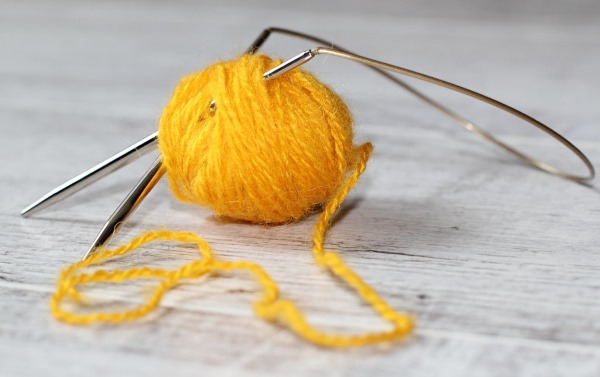
Knitting tools are made of metal, bone, wood, plastic. Metal knitting needles have a smooth surface, and wool threads slide easily on them. Wooden tools weigh less and can be taken with you on a trip.
Patterns and step-by-step description of knitting hats for girls
It is better to knit simple hats with knitting needles for girls (patterns, which are very diverse, should be carefully studied before starting work), which do not require much time to make. A novice craftswoman should not undertake the manufacture of a product of increased complexity. A beautiful children's thing can be created using bright voluminous threads.
Winter hat with earflaps with a simple pattern
Classic Russian headdress with ears, designed for the cold season. Knitting is done in two threads. They can be of the same color or two different tones. The product is designed for a child of 7 years. Size chart for children from 0 to 9 years.

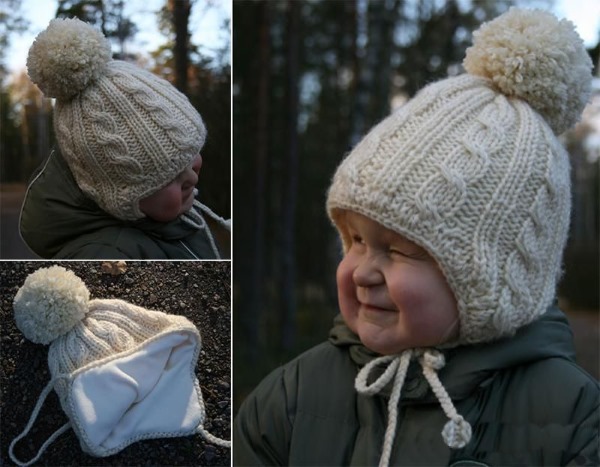
Materials and tools:
- 100 g of any natural wool yarn (300 m in 100 g);
- Needles No. 5.
Abbreviations used:
- IZP - purl loop;
- LP – front loop;
- LPPR-front, crossed from the drawstring.
Description of the work process:
- The product is knitted starting from the ears. To do this, cast on 6 loops on the knitting needles, then knit 3 rows of IZP (garter stitch).
- The fourth row is knitted according to the pattern: 3 IZP, 1 LPPR, 3 IZP.
- Fifth row: all sts.
- Sixth row: 3 IZP, 1 LPPR, 1LP, 1 LPPR, 3 IZP.
- Seventh row: all sts.
- The eighth row and subsequent ones are increased according to the pattern, up to 19 loops on the needle.
- Knit 5 rows without increasing;
- The tied eye is put aside and a second identical detail is made.
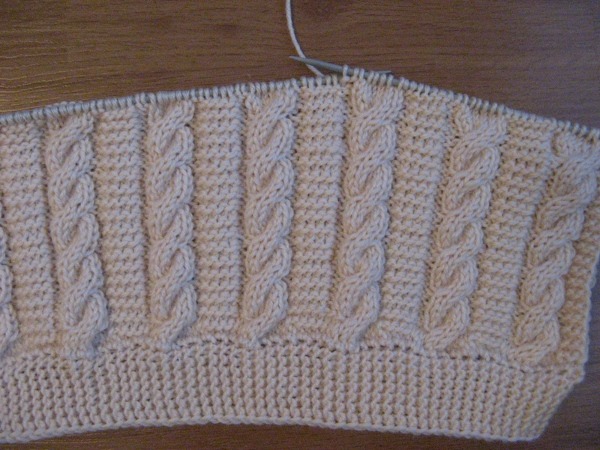
- Separately, 15 loops are cast on to the knitting needle, and the knitted ears are added to them on the sides.
- The ears are knitted according to the previous pattern;
- The 15 stitches cast on for the back of the hat are knitted with a voluminous elastic band.
Attention. The pattern of the back of the product is knitted according to the diagram:
- Having knitted 3 cm from the first row of the back part, cast on 21 loops in the front, and close the knitting into a whole circle.
- The work continues in a circle.
- After 4.5 cm, change the pattern to front stitch.
- Knit with the front surface upwards without increasing 7.5 cm.
- Move on to decreasing. To do this, all loops are divided into six parts, each border loop is marked with a contrasting thread.
- Every 2 loops are knitted together.
- Continue decreasing until there are 6 loops left on the needles.
- The last 6 loops are collected on one thread, tightened, and the knot is brought to the wrong side of the product.
- Ribbons are sewn onto the ears.
A hat for the cold season can be made double. The back part is knitted in the same way as the front part, then they are sewn together. The back part can be sewn from fleece. The measurements for the cut are taken from the finished product.
Hat for newborn
Knitted hats for girls (schemes of interesting models, many thematic publications offer) are made from beautiful yarn, decorated with lace, knitted flowers, berries. The appearance of the finished product depends on the imagination of the needlewoman. The more decorative elements, the simpler the knitting pattern should be. A children's hat can be knitted in a few hours.
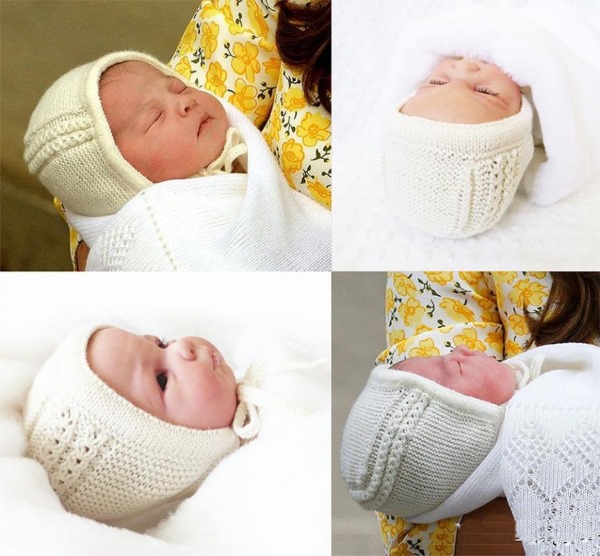
For this you will need materials and tools:
- straight knitting needles;
- a set of five identical knitting needles;
- 50 g white yarn (blended yarn containing acrylic and wool);
- small balls of colored threads for decoration (brown, orange, yellow)
Job Description:
- the product is knitted with orange thread, 19 loops are threaded onto each of the 4 stocking needles;
- knit 3 cm upwards with a regular elastic band (alternate 1 L.P., 1 I.P.);
- change the thread to white;
- knit 11 cm with the front surface (all loops in rows L.P);
- change the thread again, knit 1 row with orange yarn;
- the upper loops are closed;
- the product is folded together and sewn along the top edge;
The hat is ready. Now it remains to decorate it with decorative elements. These can be two small pompoms, applique or crocheted flowers. You can decorate a hat for a newborn girl with embroidery. The simplest trim is knitted on knitting needles. The maximum possible number of loops is cast on with yellow thread. Knit LP 1-2 rows. The loops are closed to the end of the row.
The resulting ribbon is wound on a piece of cardboard measuring 4 by 5 cm. A thread is passed under the wound rows. Both ends are connected, and a knot is tightened. The bundle is removed from the pattern and sewn instead of a pom-pom to one of the two pointed ears of the cap. The same decorative element is made from brown yarn.

The finishing details can be crocheted.
Summer openwork hat
Knitted hats for girls, patterns of headwear for the warm season, are offered in large quantities by knitting magazines. They are made from separate elements or knitted as a whole product in a circle on stocking needles.
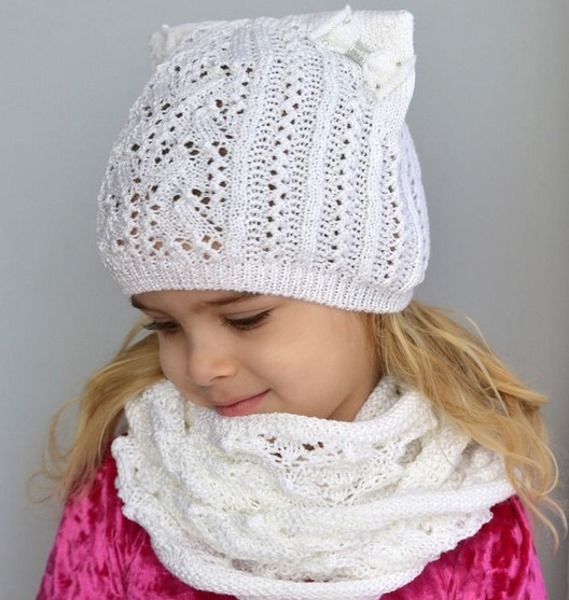
Before you start working, you need to take two measurements from the child's head:
- circle;
- the distance from the middle of the ear to the crown.
After this, you need to knit a pattern sample and calculate the number of loops and thread consumption. In the "Wave" pattern, the pattern rapport is repeated every 3.5 cm. This means that for a two-year-old girl with a head circumference of 46 cm, 13 rapports will be required.
Each pattern repeat requires 8 loops. The length of the first row will be: 13 rapports multiplied by 8 + 2 edge loops and 1 loop for lifting the row = 107 loops.
Important: The elastic band of the cap should not squeeze the child's head.
The first knitted rows must be tried on; if the first 5 cm are too tight, the product is unraveled and work is started again, taking into account adjustments for freedom of fit.
To make a hat you will need the following materials and tools:
- 50 g of green blended yarn (45-50% cotton, other components polyamide, acrylic);
- knitting needles No. 2, 3-3;
- hook for assembling the product.
Garter stitch pattern:

Progress of work:
- the first 6 rows are knitted in garter stitch;

- From the seventh row, they begin to knit the “wave” pattern.

 Connect 3 loops, then swap the first and second loops from the left needle. With the right needle, knit 1 LP through the third loop.
Connect 3 loops, then swap the first and second loops from the left needle. With the right needle, knit 1 LP through the third loop. - the drawing is repeated according to the given scheme 6 times;

- when the height of the product is equal to the distance from the child’s ear to the top of the head minus 2 cm, move on to the front surface;
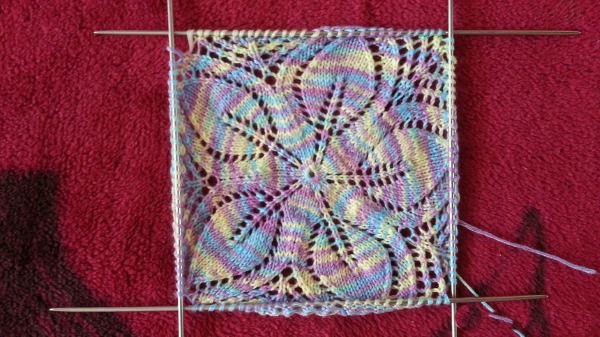
- in each front row, knit 3 sts with a rearrangement together, thus the cap begins to narrow towards the crown;
- The remaining loops are transferred to the hook, then the thread is pulled through them and the loop is tightened.
Spring hat
The demi-season headdress is knitted from thin woolen threads. For a spring hat, medium-density yarn is used. Otherwise, the work is carried out according to the same patterns as when creating warm winter clothes. The simplest model of a spring hat with ears.
It is knitted in a circle, without dropping loops. It takes several hours to make such a headdress. The model is suitable for girls from 2 to 14 years old.
The work is carried out in the following sequence:
- measurements of the head circumference and the height of the finished product are taken;
- The required number of loops is cast on using circular knitting needles;
- the first row is closed, and further knitting goes up in a circle;
- knit several rows of elastic (3-4 cm);
- all subsequent rows are knitted according to the basic pattern 1 LP, 1 IP;
- the fabric is knitted to the desired height;
- the last row is closed;
- the thread is cut;
- The hat is folded in half and sewn along the top edge.

The pattern of the main fabric can be knitted according to any of the patterns that do not involve decreasing the number of loops towards the crown.
Any pattern intended for knitting pullovers and scarves will do. The fabric of the hat can be knitted from square elements.
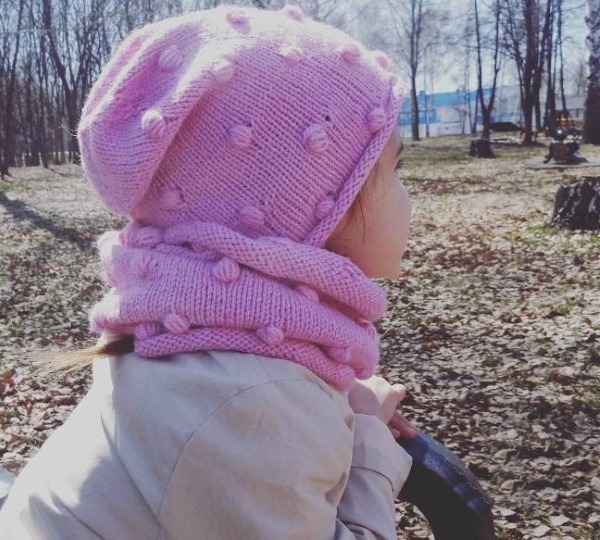
It is done like this:
- The required number of loops is cast on circular knitting needles. Their number should be a multiple of 6 or any other number, the number of loops in one square is chosen by the craftswoman herself.
- Several rows of regular elastic are knitted.
- If there are 120 loops in a row, then further knitting is carried out according to the pattern 6IP, 6LP.
- The pattern is repeated 6 times, then knitting is done in a checkerboard pattern. IP are knitted over the LP.
- The pattern is repeated 6 times, then the IP is knitted over the LP again.
- The fabric is knitted to the desired height of the product, but so that the pattern ends with a full square.
- The last row is closed;
- The hat is folded in half and sewn along the top edge.
A spring headdress can be assembled from separate colored squares. To do this, knit the required number of identical elements from threads of different tones. The squares are all sewn together, and an elastic band is tied to the bottom edge.
Beret for children
Knitted hats for girls (patterns of models of children's hats can be found for every taste) often have a similar shape and appearance. The beret is different from any other hats.
Brief description of the work progress:
- the child's measurements are taken;
- cast on the required number of loops;
- knit several rows of elastic;
- begin to knit rows with a sharp increase in the number of loops;
- when the desired diameter is reached, begin knitting decreasing rows;
- the last 6 loops are pulled together with thread;
- the knot is brought to the inside of the product.
Berets can be knitted not from the elastic, but from the crown. The work is done exactly the same, only in reverse order. The finished product can be decorated with a pompom, embroidery. Even a novice needlewoman can knit a simple beret model with her own hands.

The work is carried out in the following sequence:
- cast on 130 stitches using circular knitting needles;
- knit 5 cm up from a regular elastic band;
- the loops are divided into 7 equal parts;
- the row is knitted with IP, and at the border of each segment three LP are knitted;
- in the next row, 5 LP are knitted in each LP, and 1 LP in the IP of the previous row;
- the product is knitted to the required diameter according to the pattern;
- begin decreasing by knitting 5 LP into one loop;
- after this, the number of IPs is reduced to a minimum;
- when there are 10 loops left on the knitting needles, they are collected on the hook and the thread is pulled through;
- the thread is pulled into a knot;
- The finished beret is decorated with beads, crocheted flowers, and glass beads.
Important: Circular knitting is knitted only with the front side facing forward.
Knitting does not proceed from left to right, but is carried out rising in a spiral in one direction.
Beret for a 2 year old girl with a relief pattern:
The product is knitted on circular needles. All work is carried out in compliance with the usual stages of beret production.
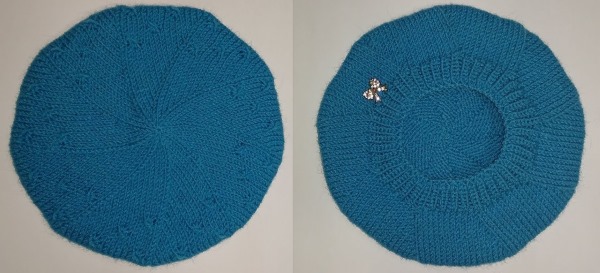
The relief pattern is knitted according to the diagram:
- 1-2 rows: front surface;
- Row 3: 2 sts together, 1 st, yarn over, then repeat the pattern rapports to the end;
- 4th row from beginning to end LP.
- from the fifth row the product is knitted on double-pointed needles, with 12 loops distributed on each of the 4.


Beret with braids for girls 5-6 years old:
- cast on 90 stitches using circular knitting needles;
- knit in a circle a regular elastic band 1LP, 1IP;
- when the width of the elastic reaches 3-5 cm, start knitting 1 row to increase, after each P, knit 1 crossed yarn over;
- the resulting number of loops is divided into 15 loops;
- 12 loops are left for knitting braids, the next 3 will be used for knitting garter stitch;
- There are 8 rapports in a row, 2 rapports are knitted in height;
- then the braids are knitted according to the pattern:
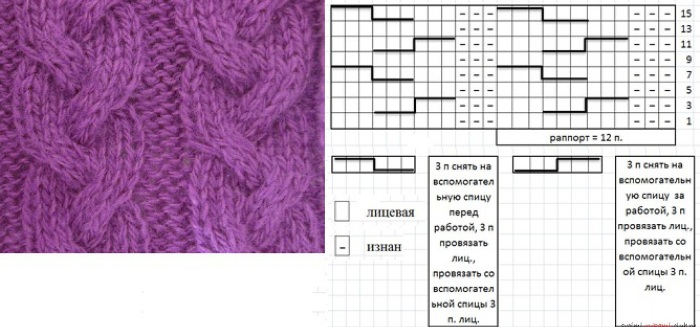
After the cap is knitted to the desired height, begin to decrease the number of loops. Finish knitting by decreasing the purl loops. In a new row, knit three IP into one. Then decrease the number of loops in the pattern by knitting 2 P into one. The remaining loops are collected on the hook, and the working thread is pulled through all at once. Tie a knot. The crown is decorated with a pom-pom.
Knitting patterns differ from each other in their level of complexity.
Any needlewoman will easily find suitable samples of a knitted hat for a little girl for her skill level. Children's things are knitted quickly, due to the small size of the products. They require little yarn, and ready-made hats and scarves for babies are expensive in stores. Therefore, a passion for knitting brings not only pleasure, but also economic benefits.
Article formatting: Anna Vinnitskaya
Video about the knitting pattern of a hat for girls
A hat with a fold that forms ears and a detachable snood:


Set of hat and scarf knitted. Model, diagram and description. The set includes a scarf knitted with a simple pattern of face loops, and a hat with a relief pattern of cables and diamonds. The hat sits deep on the head.
The description of knitting the hat is calculated for a head circumference of 56 cm. This model is made on thick knitting needles, which will allow you to knit the headdress quite quickly.